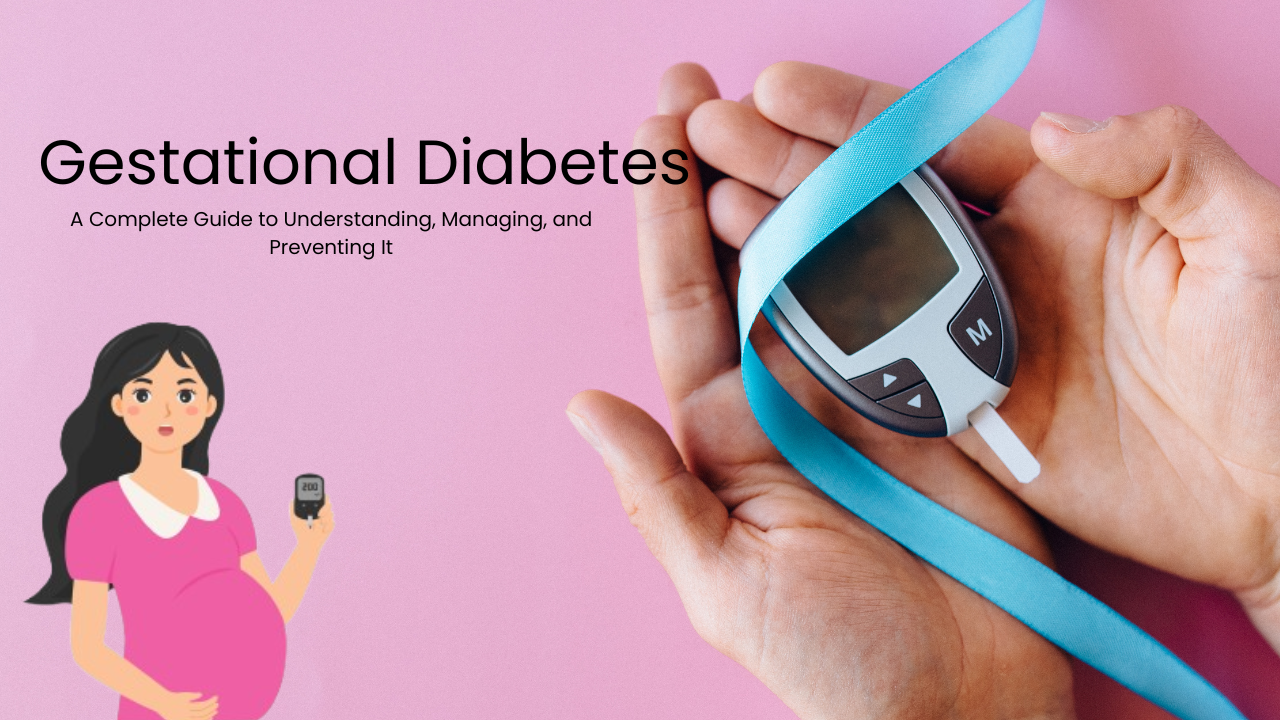Introduction
Pregnancy is a memorable journey filled with excitement, anticipation, and a fair share of challenges. Among these challenges, Gestational Diabetes Mellitus (GDM) also commonly known as Diabetes of Pregnancy is one that many expecting mothers’ encounter. While the term might sound intimidating, understanding the condition, its risk factors, and effective management strategies can help ensure a healthy pregnancy for both mother and baby.
What is Gestational Diabetes?
Gestational diabetes is the most common type of diabetes that develops during pregnancy when the body cannot produce enough insulin to meet the increased demands. This leads to elevated blood sugar levels, which can impact both the mother and baby’s health if not properly managed. Unlike type 1 and type 2 diabetes, GDM typically resolves after childbirth, though it does increase the risk of developing type 2 diabetes later in life.
Prevalence of Gestational Diabetes
According to global estimates, GDM affects around 7-16% of pregnancies worldwide, with variations depending on ethnic background, lifestyle, and healthcare access. The prevalence is notably higher in countries with increasing obesity rates and sedentary lifestyles. In some regions, particularly in South Asia, the Middle East, and parts of Africa, the rates can be even higher, making GDM a significant public health concern.
Risk Factors for Gestational Diabetes
While any pregnant woman can develop gestational diabetes, certain factors increase the risk. Some of the most common risk factors include:
- Obesity or Overweight: Excess body weight before pregnancy is a major contributor.
- Family History of Diabetes: Having a close relative with diabetes increases susceptibility.
- Age: Women over 30 years old have a higher risk.
- Previous GDM: A history of gestational diabetes in a previous pregnancy raises the chances of recurrence.
- Ethnicity: Women of South Asian, Middle- Eastern, Hispanic, African, and Native American descent are at a higher risk.
- Polycystic Ovary Syndrome (PCOS): This hormonal disorder is linked to insulin resistance, increasing GDM risk.
- Past history of delivering a large baby- baby born with birth weight of more than 9 lb or 4kg in previous pregnancy.
- Unhealthy Diet and Sedentary Lifestyle: Poor eating habits (wrong selection of food & higher consumption of refined food, junk food and white rice) and lack of adequate physical activity contribute to insulin resistance.
- Excessive Weight Gain During Pregnancy: Rapid weight gain can strain the body’s ability to regulate blood sugar.
Can Gestational Diabetes Be Prevented?
While it’s not always possible to prevent GDM, adopting healthy lifestyle habits before and during pregnancy significantly reduces the risk. Steps to take include:
- Maintaining a Healthy Weight Before Pregnancy: A healthy BMI lowers the risk.
- Eating a Nutrient-Dense Diet: Consuming a healthy and balanced diet can prevent GDM. Limiting refined food, sweetened beverages, avoiding caloric dense food (ice- creams, doughnuts, cakes etc.) fruit juices, & minimizing processed sugars can be of great help. If you are at high risk, seeing a Nutritionist before planning for pregnancy or as soon as you get pregnant can help you in preventing GDM and excess weight gain.
- Staying Physically Active: Regular exercise for 30-60 mints improves insulin sensitivity and helps in maintaining healthy weight.
- Avoiding Excessive Weight Gain During Pregnancy: Following recommended guidelines for weight gain based on pre-pregnancy BMI.
Diagnosis of Gestational Diabetes
Gestational diabetes is typically diagnosed between 24 and 28 weeks of pregnancy through a glucose tolerance test (GTT) but people at high risk must be screened as soon as the pregnancy is confirmed. The process involves:
75gms Oral Glucose Tolerance Test (OGTT): This is recommended by WHO & American Diabetes Association. It Should be done in morning, after 8hrs of Fasting. First sample – in Fasting then Drink 75gm of Glucose drink then Second sample – after 1hr Third Sample – after 2hrs of drinking glucose drink.
GDM Is diagnosed if any one value is abnormal –
- Fasting sugar or Glucose – >92mg (5.1mmol/l)
- 1hr Post-glucose value – >180mg% (10mmol/l)
- 2hrs Post-glucose value – > 153mg% (8.5mmol/l
Potential Complications of Gestational Diabetes
If not managed properly, gestational diabetes can lead to complications in both mother and child such as:
- Preterm Birth: Higher chances of premature labor.
- Preeclampsia: A condition in mother causing high blood pressure and organ damage.
- More chances of Caesarean Section or other obstetrical intervention.
- Macrosomia (Large Baby): This increases the risk of birth complications and C-section deliveries.
- Neonatal Hypoglycemia: Babies born to mothers with GDM (if uncontrolled) may have low blood sugar at birth.
- Higher Risk of Type 2 Diabetes: Both mother and child face an increased risk of developing type 2 diabetes later in life. There is up to 50% risk of developing Type 2 Diabetes in mothers within 5yrs after delivery. There is an increased risk of obesity in these children if not take care of well.
Management of Gestational Diabetes
Managing gestational diabetes properly is crucial to prevent complications for both the mother and baby. The good news is that most cases can be effectively controlled with lifestyle modifications and, in some cases, medication. Very few patients need insulin.
1. Healthy Eating Habits
A balanced diet is the cornerstone of managing GDM. Up to 90% of cases can be managed with a healthy balanced diet and regular physical activity under proper guidance. A nutritionist must be consulted for expert guidance and follow-up. Each pregnant woman has different dietary needs, and it change with each trimester so having a Nutritionist can be of a great help. Key dietary strategies include:
- Emphasizing complex carbohydrates (whole grains, vegetables, and legumes) over refined carbs.
- Incorporating lean proteins (chicken, egg whites, low fat dairies, fish, tofu, beans) to stabilize blood sugar.
- Including healthy fats (avocados, nuts, olive oil) in moderation.
- Eating smaller, frequent meals to prevent sugar spikes.
- Using fruits and nuts as snacks between the main meals.
- Limiting sugary foods and beverages like soft drinks, desserts, and processed snacks.
2. Regular Physical Activity
Exercise helps the body use insulin more effectively. It is safe to start physical activity from 12 weeks onwards unless you have been advised to have bed rest due to any complication. Safe activities include:
- Walking for at least 30-60 minutes daily, walking 15-20 minutes after each meal can be of great help in controlling post meal sugars, relieving acid or reflux related problems and avoiding excess weight gain.
- Prenatal yoga or stretching exercises.
- Swimming, which is gentle on the joints.
- Low-impact aerobics, as advised by a doctor.
3. Monitoring Blood Sugar Levels
Women with GDM need to check their blood sugar levels regularly using a glucose meter or CGM (Continuous Glucose Monitoring System). The frequency of testing depends on the severity of the condition and the doctor’s recommendations. Most of women need at least 4 times checking- Fasting test in morning and 1 or 2hrs after each major meal. Woman on very high risk or o insulin can use CGM to monitor throughout the day without having a prick. The desired targets are – Fasting Glucose (after > 8hrs of dinner) should be less than 95mg% (5.3 mmol), & post- meal should be less than120mg% after 1hr (6.7mmol/l) or 140mg% after 2hrs (7.8mmol/l).
4. Medication (If Necessary)
If diet and exercise alone aren’t enough to control blood sugar levels, insulin therapy or oral medications like metformin may be prescribed. These medications help regulate glucose levels without harming the baby.
5. Frequent Medical Check-ups
Regular prenatal visits allow healthcare providers to monitor the baby’s growth and detect any potential complications early. Additional ultrasounds and non-stress tests may be recommended to ensure the baby’s well-being.
Conclusion
Gestational diabetes may seem daunting, but with proper knowledge and proactive management, most women can have a healthy pregnancy and a smooth delivery. Early diagnosis, a well-balanced diet, regular physical activity, and close monitoring of blood sugar levels are key to ensuring the best outcomes for both mother and baby. Additionally, adopting a healthy lifestyle postpartum can help reduce the risk of developing type 2 diabetes in the future.
“Consider GDM as a warning signal for future Diabetes and change your lifestyle to prevent it forever.” Dr. SKM





